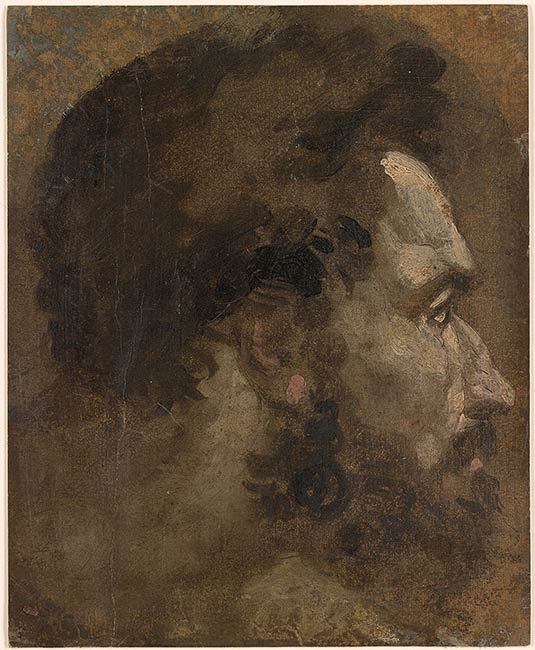
Together with Head of an Old Man with Open Mouth (I, 19b), also at the Morgan, Head of a Bearded Man in Profile to the Right is one of the several head studies made by Beccafumi with oil on paper, an almost unprecedented technique before the artist’s time. While most of these sheets are connected with Beccafumi’s frescoes in the Palazzo Pubblico, Siena,1 the present sheet has been recognized as a preliminary drawing for the figure of the good thief (the first from the left) in the Descent of Christ into Limbo, a large altarpiece that Beccafumi painted for the Marsili chapel in San Francesco, Siena, and now in the Pinacoteca Nazionale there.2 The painting was presumably made between 1530 and 1535—a date that corresponds to the artist’s other drawings in oil, which he particularly favored as a medium during the mid-1530s.3
The Morgan sheet is extensively incised with a stylus, a practice that recurs frequently in Beccafumi’s oil sketches and that is similarly identifiable in a few of the artist’s chalk drawings, as, for example, Gaius Mucius Scaevola Holding His Hand in the Fire (1964.7). In Head of a Bearded Man the incised lines are clearly visible along the profile of the head, on the contours of the hair, around the ears, and on the neck. Evelyn Lincoln recently proposed that the incised lines were made as part of the preliminary sketch, but in fact the marks of the stylus clearly appear above and not under the impasto and consequently cannot be considered a preliminary draft for the composition. Sanminiatelli more convincingly argued, in contrast, that the incisions visible in Beccafumi’s oil drawings were made to transfer the design to the painting support. It is hard to determine if this technique was used consistently by the artist, for his oil sketches have not been systematically examined. The Head of a Bearded Man corresponds exactly in size to the head of the good thief in the Descent of Christ into Limbo, and it thus appears that the Morgan drawing was transferred to the panel without any alteration and at full scale. At least in this case, the sheet actually served as a guideline for the painting.
The fluid, impressionistic manner that characterizes the Morgan sheet would suggest that the drawing, as well as others among Beccafumi’s oil sketches, was made quickly, perhaps after a live model. To this regard, Sanminiatelli noted that the profile of the man bears a close resemblance to the artist’s features as revealed in the Self-Portrait in the Uffizi, similarly executed in oil on paper.4 Rare in the practice of Beccafumi’s contemporaries, drawings made in this same technique began to be produced more broadly at the end of the century, especially by the Sienese artists Francesco Vanni and Rutilio Manetti and by the Carracci family in Bologna.5
—MSB
Footnotes:
- In addition to the two drawings at the Morgan, other studies of heads in oil on paper that have been accepted unreservedly as Beccafumi’s work include: Rijksmuseum, Amsterdam: Head of a Putto (inv. rp-t-1954-36) and Head of a Bearded Man (inv. rp-t-1954-38); Brighton Museum and Art Gallery: Head of a Bearded Man Turned to the Left (inv. fa 102324), Head of a Young Man Turned to the Left (inv. fa 102325), and Head of a Girl (inv. fa 102326); Harvard Art Museums, Cambridge, MA: Head of Cincinnatus (inv. 1933.151) and Head of an Old Man Turned Three-Quarters to the Right (inv. 1965.359); Gabinetto Disegni e Stampe degli Uffizi, Florence: Self-Portrait (inv. 1731f) and Heads of Two Children (inv. 19108 f); British Museum, London: Head of a Child Looking Up (inv. sl,5224.73), Head of a Bearded Man Looking Up to the Right (inv. 1953,1212.3), and Head of an Old Woman Looking Down to the Left (inv. 1953,1212.4); Musée du Louvre, Paris: Head of a Man in Profile (inv. rf 53005); Princeton University Art Museum: Head of a Putto (inv. x1948606) and Head of a Young Woman (inv. x1948-607); Galleria Borghese, Rome: Head of a Youth (inv. 453); and Collection Chigi Saracini, Siena: Two Female Heads (inv. 400).
- See Torriti 1998, no. P66.
- The altarpiece was initially believed to have been produced around the mid-1520s. More recently, however, scholars have agreed that the painting was probably made later, around 1530–35. For a complete overview of its chronology, see Torriti 1998, no. P66. On the chronology of Beccafumi’s oil sketches, see Sanminiatelli 1955, 35.
- Gabinetto Disegni e Stampe degli Uffizi, Florence, inv. 1731f.
- Vanni may have been inspired as much by contemporary Carracci examples as by those done a generation earlier by his fellow Sienese Beccafumi; see Marciari in New Haven 2013, 5–7.
Watermark: none visible through lining.
Hawley, Joseph Henry, Sir, 1813-1875, former owner.
Hawley, Henry, Sir, former owner.
Murray, Charles Fairfax, 1849-1919, former owner.
Morgan, J. Pierpont (John Pierpont), 1837-1913, former owner.
Morgan, J. P. (John Pierpont), 1867-1943, former owner.
Rhoda Eitel-Porter and and John Marciari, Italian Renaissance Drawings at the Morgan Library & Museum, New York, 2019, no. 91.
Selected references: Judey 1932, no. 226; Sanminiatelli 1955, 39; Hartford 1960, no. 67; New York 1965-66, no. 62; Sanminiatelli 1967, no. 23; Baccheschi 1977, no. 116; MacAndrew 1980, no. 114-1; Gordley 1988, no. 82, under no. 87, and under no. 107; Siena 1990, no. 127; Torriti 1998, no. D111, and under no. P66; Lincoln 2000, no. 83; London 2007-8, under 110 and 111; New York 2007, 38-39.
Stampfle, Felice, and Jacob Bean. Drawings from New York collections. I: The Italian Renaissance. New York : Metropolitan Museum of Art : Pierpont Morgan Library, 1965, p. 47, no. 62.
Dervaux, Isabelle. Drawing connections: Baselitz, Kelly, Penone, Rockburne, and the old masters. New York: Morgan Library & Museum, 2007, p. 38-39 (repr.)
